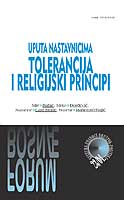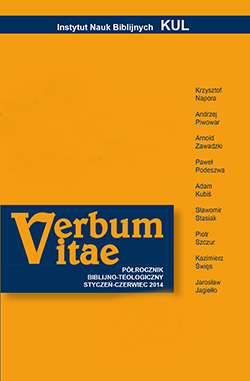
We kindly inform you that, as long as the subject affiliation of our 300.000+ articles is in progress, you might get unsufficient or no results on your third level or second level search. In this case, please broaden your search criteria.








Saint Augustine describes the creation of woman as a voluntary and intentional act of God. Man is being prepared to receive her. Woman is created as a rational being. Together with man, she brings to fruition the blessing of fecundity and, at the end of times, she will be saved in her own body. The creation of woman from man’s rib becomes a symbol of the relationship between the soul and the body. Woman, being subject to man who is obedient to God, is a figure of the body being subject to the soul obedient to the Lord.
More...
The purpose of the present article is to present the theme of woman in John Paul II’s “theology of body”. The sign of our times is an attempt to relativize the importance of human’s nature in the name of equality between man and woman. It seems that the most satisfying answer to this approach may be given by explaining the true meaning of the human nature embodied in male and female. After having described the foundations of the Christian anthropology, which were exposed by John Paul II in his Wednesday catecheses on the theology of body, the article envisages the specificity of the human nature bound to the idea of the divine image in man. Subsequently, the author depicts the primary human experiences: loneliness, unity and nakedness. Each of them reveals the depths of the human nature’s mystery which is the same for male and female, even if it is expressed in two different ways. Woman participating together with man in the same nature has nevertheless her proper specificity bound to her “genie” which she shares by living her life as a gift and offering herself to others.
More...![Kobiety w genealogii Jezusa [Mt 1,1-17]](/api/image/getissuecoverimage?id=picture_2011_13554.png)
Matthew binds the story of Jesus and the Old Testament message to show the one coherent plan of God (the triple repetition of the fourteen generations) which embraces the whole of the entangled human history (the names contained in the genealogy point to the tortuous lives of protagonists). The mention of women, on the other hand, introduces the theme that will be developed from the very beginning of the narration: the righteous one fulfills the will of God even against his own plans and projects. The example of Mary’s spouse, Joseph, demonstrates that also in the story that continues in the NT every relationship with God and others must be built upon righteousness. The survey of the different terms referring to righteousness confirms that the presence of women in the genealogy underscores the importance of this theme which belongs to the theological core of the Gospel of Matthew.
More...
The study is an attempt to reveal Miriam’s contribution into the process from which the biblical Israel emerged as a nation. The author of the article focuses on two fundamental texts, that is, Exod 15:20-21 and Numbers 12. After having presented the literary structure of the selected periscopes, making additional references to other biblical texts of the Old Testament, he tries to portray Miriam as a singer, a precursor of worship, a prophetess and a guide of the people. Highlighting her suffering as an indispensable element of the prophetic charism, he underlines its importance for the verification and authentication of Miriam’s prophetic authority. According to the author, the prophetic charism of Miriam was shown by the hagiographer as instilling hope and consisted, among others, in “conveying” her brethren from the visible into the invisible world, from the present into the future, and from the temporality toward the eternity.
More...
The unequivocally negative role of women, described as a „harp” of Satan, find its substratum in the anthropological concept of Afrahat which is based on a particular hierarchy of creatures’ virtues. Afrahat’s mistrust of women did not result from the „ontological motives”, but from some practical considerations which were its source (Guillaumont). Faithfulness to the biblical concept of creation does not allow the author the complete negation of the value of women although, in the specific advice given to the „athletes”, the issue was caused to undergo various modifications. In these circumstances, there was an evidence of a radical stance in the sage’s appraisement of women, namely, the principle of the degrees of good in creatures: all the works of God are good, but some are worse. It is not without good reason that the uncompromising attitude to women is most frequently found in the De¬monstrations on the Sons of the Covenant and On Virginity and Holiness, which touch on the themes of virginity and celibacy.
More...
The issue of the vocation of woman in The Book of Ben Sirach begins with the presentation of the author and the purpose of his teaching. Hellenistic culture influenced the customs of the Jewish believers as well as their views on human relationships and the image of woman as described in the biblical tradition. Despite the many positive aspects of woman presented in the book, commentators often regard Ben Sirach as a misogynist who noticeably reduces women’s value and social position. A deeper reading of the book in its cultural context, however, enables us to see a strong diversity and multiple contrasts in the author’s presentation of woman. The vocation of woman in The Book of Ben Sirach, like other topics, draws on the traditions of biblical Israel, especially on the Book of Genesis.
More...![Żona zbawiająca męża [1 Kor 7,16]?](/api/image/getissuecoverimage?id=picture_2011_13554.png)
The question “How do you know, wife, whether you will save your husband?” (1 Cor 7:16) closes the so called ‘Paul’s marriage privileges’ running in the preceding verses of 1 Cor 7. The issue expressed with a question mark refers to mixed marriages. The present essay aims to explore this already much harvested text from a new exegetical perspective. In the first part, the socio-religious context of the audience in the 1 Corinthians is exposed: the background of their beliefs and dilemmas concerning marriage. In the second part, the issues of the married women position in Judaism and in the Greco-Roman culture of the period are explored. The last step of the investigation is the analysis (mainly rhetorical) of Paul’s argumentation in 1 Cor 7:16 in the context of 1 Cor 7:12-16. The final conclusion is that a Christian wife (as well as a Christian husband) cannot save her spouse because, according to Paul’s argumentation in the passage, the responsibility for believers’ salvation belongs solely to Christ. Nevertheless, a Christian wife can sanctify her husband.
More...![Rola Rachab w zajęciu ziemi obiecanej [Joz 2,1-24]](/api/image/getissuecoverimage?id=picture_2011_13554.png)
The article deals with one of the women presented in the Deuteronomistic History, namely, Rahab, the harlot. The essay contains some necessary elements of the literary analysis which introduce the reader into the preliminary understanding of the text. The central part of the elaborate, which is the exegesis of the dialogs, purports to show the importance of Rahab’s actions for the conquest of the Promised Land. The special object of the author’s interest are the deeds of the woman including her profession of faith (2:9-11) which is the pivotal point of the analyzed section. The article proves that, besides guarding the spies’ way of escape, Rahab’s role consists in confirming the words of God before Israel and in stressing his power to put them into effect. Thanks to such an incentive the Israelites are able to enter the Promised Land.
More...
The purpose of the present article is the analysis of the female characters in the narration of Gen 11:27 – 25:18. At the beginning, the author describes the factors determining the religious and social status of women in the patriarchal society. This society, even though exhibiting the patriarchal order, is built on the foundations of faith which grants man and woman the same dignity and position before God. In the subsequent part of the article, the authors shows different female protagonists appearing in the Abraham’s cycle. Sarah is depicted as the model of a genuine Hebrew wife and mother. She fulfills her vocation in an exemplary way giving birth to Isaac and ensuring her family the best conditions possible for their existence. Lot’s wife and daughters stand in a stark opposition to Sarah. Their actions bring doom upon the families they represent and thwart the opportunity of their continuous growth comparable to the one experienced by Abraham’s generation.
More...
The theme of the diaconal ministry of women has not been discussed in any article in the area of the polish biblical researches, as yet. The present essay tries to fill this gap by analyzing the three texts: Rom 16:1-2; Phil 1:1 and 1 Tim 3:11. The witness of Rom 16:1-2 provides the exegetes with the richest data concerning the theme of the diaconal ministry of women in the Pauline communities about the middle of the 1st century. The reference to the diaconal ministry made with the use of technical expression διάκονοι points not only to male but also to female ministers in the Church of Philippi. The diaconal ministry of women consisted in guiding the local churches and maintaining connections between them.
More...![„Matka Jezusa” – Jej tożsamość I rola w historii zbawienia [J 19,25-27]](/api/image/getissuecoverimage?id=picture_2011_13554.png)
The author of the article, in light of John 19:25-27, analyses the role of Mary addressed by the evangelist with the characteristic title “Mother of Jesus”. Special attention is paid to the relationship which Jesus creates between her and his “beloved disciple”. In the scene on the cross the Lord speaks to them in words: “Woman, behold, your son!” (v.26), and “Behold, you mother!” (v.27). Mary as an individual (Mother of Jesus) and as a representative of the community of faith (either Israel or Church) reveals in an ideal way the grandeur of woman. Her love gives life. Her faith inspires the people of God to show an unconditional trust in Jesus, the Messiah of Israel and of the Church.
More...
Dans le contexte du débat contemporain sur l’héritage chrétien de l’Europe, l’Église souligne l’unité des peuples européens, fondée sur une foi chrétienne commune, et vise les enjeux pour l’Europe dans ses déclarations d’étique sociale. Face aux grandes questions comme le nationalisme, la présence des autres religions, l’immigration, la situation des pays de l’Est, et de la pauvreté, l’Église reconnaît la priorité de la paix et de l’unité de la famille humaine. Les chrétiens sont invités à s’intéresser aux plus pauvres, à entrer en dialogue concret avec les étrangers, à nouer des liens avec les autres religions, en particulier avec l’Islam. Il s’agit donc pour l’Europe de s’ouvrir à d’autres peuples, d’autres cultures, d’autres manières de croire. Dans se cadre l’Église doit répondre à deux importants exigence, celle de l’œcuménisme et de la diaconie. Une responsabilité qui incombe aux Églises c’est de promouvoir une éthique de la paix, de la démocratie et des droits de l’homme.
More...
In Eastern Europe Romania lies among different cultural boundaries: the orthodox culture – which is Eastern – meets with the Western catholic and protestant cultures. This special situation can be considered a challenge by the churches, this being stressed also by the fact that the religion is sticked to the nationality (or national identity). The main aim of this study is to prove that although the image of God in different religions has an important influence on the culture, it is very important to state that the root of the conflicts among the different cultures does not lie in religion. As a conclusion: Huntington’s Clash of Civilisations-theory concentrated on religion – at least in case of Transylvania – cannot be stated because the conflicts are much more influenced by the historical, political, economical and demographical factors.
More...